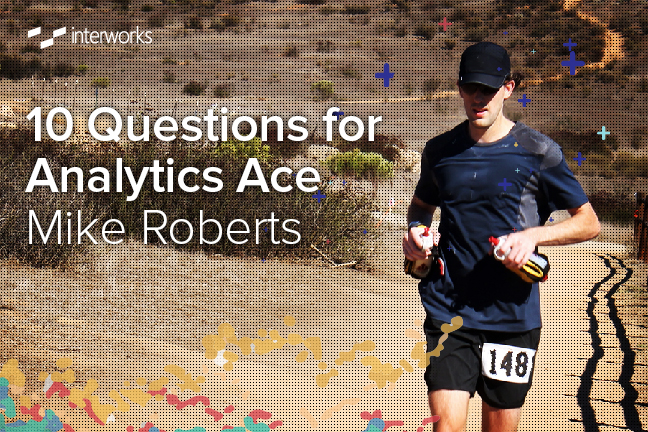10 Questions is an ongoing blog series in which Tableau Zen Master Dan Murray interviews some of the brightest folks in the world of data.

Mike Roberts is a former InterWorks BI consultant that now works for Pluralsight. Mike enjoys running. His idea of fun is running 50 to 100 miles through the mountains. He also happens to be a talented student of technology and data visualization. In Mike’s first year at InterWorks, he worked at Facebook and Google and gained insight in using Tableau with big data.
The Questions
Q: You had a very unusual start as a consultant when you worked at InterWorks. What was that like?
Roberts: Well, I must say that it was a pretty fantastic and amazing start. How many consultants can say they’ve worked for Facebook and then Google? What’s more, it was one after the other, so I was a seriously lucky individual.
I approached each company like a student going to school for the first time: eyes wide and ready to learn. Really, though, it’s hard not to when you’re surrounded by some of the world’s smartest engineers, and they constantly push you to be better each and every day.
Q: How is ultramarathon running like working in technology/data/data visualization?
Roberts: In simple terms, it requires focus, training and learning. All things we do in our field day in and day out. There are no “off” days, and you still have to do it even if the purpose (or end game) looks murky.
The great thing about the training, however, is that I get the chance to think about solutions that evade me while working at the office. The only issue is getting back to the car fast enough to write them down; otherwise, they’re lost on the road, trail or some remote location.
I think the best, most tangible, similarity between the two is the fact that running brings in so many ideas about the perfect symmetry of the natural world. Running on the trail, I can see how things just “work,” and this inspires me to do the same in the technical world.
Me: Why not carry a note-taking application on a phone that you can dictate to like Ulysses III, ByWord or iAWriter … or just the notetaking application on whatever iOS or Android device you use?
Roberts: I’ve always found that carrying extra things on a run becomes somewhat cumbersome after a few hours. However, having a toddler around the house has prompted me to carry the phone with me on longer runs, so there’s a good chance I’ll grab one of the apps you just mentioned.
Q: What do you think about when setting up security for a large Tableau deployment? What are the most important considerations?
Roberts: For starters, I always act like it’s my personal data. How would I want it protected and secured, and if it fell into the wrong hands, what actions would I take?
So, starting with that scenario in mind, the first thing to consider is the source data. Entry points are excellent ways to validate your security options. For example, if all my source data is Excel, I’d need to monitor downloads and workbooks and the data from Excel would also need to be monitored.
Once you get to the more advanced Server installs, the need to monitor becomes more vital. Are sites an option? Groups synced with AD? Each deployment will vary and come with its own unique opportunities for security. Let’s not forget that the Tableau community has created some pretty great ways to audit dashboards and surface users who’ve viewed downloaded or otherwise interacted somehow with Tableau Server.
You can see some of what we’ve done here, and the community abounds with other great examples.
Q: What do you consider to be the most important factors for good dashboard design?
Roberts: For those who know me, this won’t come as a surprise: keep it simple. There’s a really great book entitled “Chaos: Making a New Science” by James Gleick where a whole array of interesting topics are discussed, one of which has particular importance to my dashboard design: fractals.
They’re infinitely complex but stunningly simple – pretty powerful stuff that should be applied to all dashboards. From the visualization down to the data: nothing is more important than leaving out that which doesn’t belong.
Me: Oh man, I read that book a long time ago. I’m going to have to revisit it now. Another book by Gleick that I recently purchased is called “The Information: A History, a Theory, a Flood.” I haven’t read it yet. It’s on my list.
Roberts: That book sounds interesting. Might have to add it to the list.
Q: How do you deal with big data and Tableau? What are important factors to consider from network, database schema and dashboard design?
Roberts: Tableau does very well with big data if it’s planned well. Where it might cause confusion is when one does not approach it with some sort of rough idea of how to “fit” it all in. It’s very rare that anyone needs all the data; rather, it’s some form of aggregate or slice of the data they need.
Tableau makes it very easy to maneuver between detail and a 30,000 ft. view. Knowing where those switches take place is the key to making the big data work as one hopes. After all, the goal is visual analysis. As such, it should happen quickly. One should not have to wait seconds before finishing a thought or asking a question.
With regard to database schema, I think this is becoming a “non-event” in the Tableau world since it can bolt on to almost anything. Knowing how those databases work is important since they’re part of the Tableau feedback-loop. If your query is slow, there’s a good chance your dashboard will suffer, too.
Me: You are spot on Mike. I discuss this particular topic in Chapter 8 of my book as well.
Q: Mike you always struck me as a real “student” of technology. When did you first discover you had an interest in software, hardware, databases and data visualization?
Roberts: I’d say I was always interested in technology. But, the “real” interest started to materialize when I realized that technical skill sets are becoming a necessity in today’s world.
I remember the moment I made the decision to go all in: I was watching cars flow on a freeway from an office building, actively counting and sorting them into various categories. Exactly.No one is successful, not to mention a good role model, by counting cars sitting in an office chair. I’ve been on a mission ever since, and I’m enjoying every minute of it.
Q: What do you think is missing from the Tableau product line?
Roberts: Tableau is pretty deep and meets most if not all of our needs out of the box. When it doesn’t, it has a really rich set of CLI’s and API’s for those times where we’d need to “adjust” some process.
If I had some input at Tableau HQ, I might ask for more insight into the processes. For example, being able to peer into the background processes might allow some greater flexibility with extracts and eventing.
Me: I agree. We are trying to provide some of that real-time view of the gut in the recent addition of Power Tools.
Q: What capabilities do you hope to see Tableau add in future releases?
Roberts: The ability to change the Tableau Server metadata without having to download a data source and republish would be a nice one to have. Also, make the “Custom SQL” dialog box act more like an ISE. Really, though, I’m an easy man to please and will make anything work for the given circumstance.
Me: Mike, are you referring to http://www.i-s-e.com/?
Roberts: I was more referring to programs like Management Studio where you could have Intellisense and much richer features for the query editor.
Q: How often do you use Tableau in your current job and for what purposes?
Roberts: As the Director of Data Analytics for Pluralsight, I use Tableau all the time. This ranges from ad hoc dashboarding to full-reach projects that require the utmost attention to detail.
When I’m not using the desktop client, I’m usually deep diving with Tableau Server and making it do things it might not normally want to do. Tableau does a great job of allowing people to simply explore their data when they’re not sure what might be there, so there’s never a time when it’s not open on my computer.
Me: Give me an example of one way you make Tableau Server do things it might not normally want to do.
Roberts: We had a use case where we needed to catalog the metadata in each of our data sources/workbooks (not an uncommon request). We needed the fields, data types, formulas and a bunch of other stuff. There are tables in Postgres that give you high-level info, but what we needed was down to the detail level.
So, I wrote a script that pulls the workbooks/data sources from each site (if appropriate) and parses out the XML for the aforementioned info. It dumps it to a CSV on a daily schedule so we can see what has changed in the workbook, amongst other things.
Q: What did you learn during your time at InterWorks working for clients like Facebook and Google?
Roberts: Analytics and coding are both art forms. I’ve met some extremely talented engineers and analysts who handled problem solving as creatively as a great musician, poet or artist. The key, really, after having worked with Facebook and Google via InterWorks, is that success requires hard work, effort and failure. Those late nights might not bear fruit, but you can be assured that the effort will pay out at some point. If all else fails, you’ve got a great group of people who can always lend a hand.
Me: I agree. Christian Chabot touched on this during his keynote last September at Data14.
Discover More Interviews
Want to read more insightful interviews like this one? Then you’ll love our 10 Questions blog series. Check out the full list of interviews here, and stay tuned for new additions.
Need Help? Let Us Know!
There you have it. If you need help with your data infrastructure or Tableau, we have the experience, skill, and knowledge to insure your success. Contact us today to learn more.
If you’re in college and think you might want to get into this game, head to our Careers page and apply for one of our open jobs. We’d love to hear from you.


